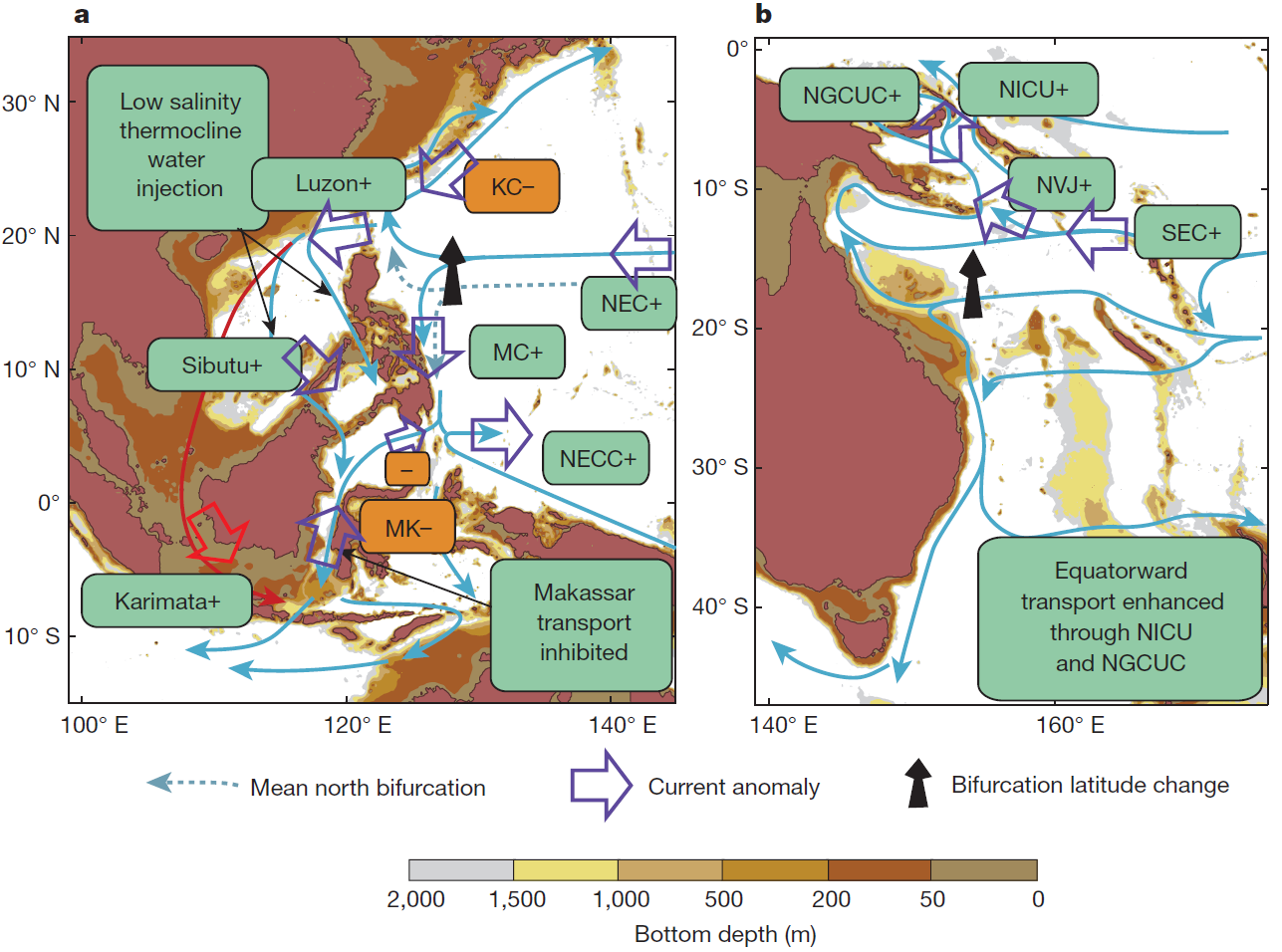Pacific western boundary currents and their roles in climate

Western boundary currents (WBCs) are swift, narrow oceanic currents found in all major oceanic gyres. Within the Pacific Ocean, the subtropical gyre WBCs are the Kuroshio Current in the Northern Hemisphere, and the East Australian Current (EAC) in the Southern Hemisphere. The Pacific low-latitude, tropical belt WBCs include the Mindanao Current (MC) in the Northern Hemisphere and the New Guinea Coastal Undercurrent (NGCUC) south of the Equator.
- The climate significances of WBC can be mainly summarized as the following points:
The subtropical WBCs are associated with the largest supply of heat and moisture into the atmosphere in the Pacific basin; - The MC feeds most of the water of Indonesian Throughflow (ITF), which links the Pacific Ocean and Indian Ocean, modifies the heat budget of the eastern Indian Ocean hence, and ultimately provides an important heat source for supporting the global thermohaline circulation;
- The Pacific low-latitude WBCs are transporting mass into the equatorial Pacific, therefore critically influencing the Western Pacific Warm Pool (a region of sea surface temperatures (SSTs) warmer than 28.5oC) and the life cycle of ENSO, as well as the East Asian monsoon and the Indian/Southeast Asian monsoon.
Pacific WBCs are subject to strong variability on intraseasonal interannual, decadal and longer timescales, in both volume transports and paths, which interact with the variability of climate modes. Take the North Equatorial Current (NEC) bifurcation latitude where NEC partitions into the equatorward MC and poleward Kuroshio for an example, it is affected by ENSO, while in turn, also influences the life cycle of ENSO. As an El Nino develops, the bifurcation moves northerly, with stronger NEC and MC, but weaker Kuroshio and ITF (see Figure 1). The increased equatorward WBC transport during an El Nino creates a strong confluence of relatively cooler water in the tropical western Pacific, and constitutes a compensatory flow for the associated discharge of the equatorial Pacific warm water, whereby mass is pumped out of the equatorial west Pacific in response to wind forcing. A large response of the SEC transport to ENSO was also revealed by recent observations.
The strong advection transport of warm water in boreal winter by the Kuroshio Current, the considerable impact on Asian Monsoon via anomalous heat content exerted by the North Pacific WBCs, and the longevity of SST anomalies generated by the WBCs, all have substantial climate impacts locally and globally.
However, the simulation of WBCs is generally poor, and uncertainty in projected changes remains high. Only a concerted international effort will close the observational, theoretical and technical gaps currently limiting a robust answer to the question how the mean climate over the Pacific will change in the coming century owing to past and future emissions of greenhouse gases.

Figure 1: Impact of El Nino on the Pacific WBC system. a, b, During an El Nino, the bifurcation moves north in both the Northern (a) and the Southern (b)Hemispheres, as indicated by the black arrows. The ocean depth is indicated as on Fig. 1c, d. Increasing (green boxes) and decreasing (orange boxes) flow anomalies during El Nino are indicated. Some currents are enhanced, while others are weakened, as indicated by the anomalies (large dark blue/red arrows). From the developing phase to approximately three-to-four months before the peak of an El Nin˜o, the Kuroshio Current (KC) decreases while the Mindanao Current increases. The ITF weakens as the Pacific-Indian pressure gradient reduces. The South China Sea Throughflow intensifies, setting up a freshwater plug. Towards the peak of an El Nino, equatorward transport enhances through NICU and NGCUC. LUC, Luzon Undercurrent; MUC, Mindanao Undercurrent; NGCC, New Guinea Coastal Current; NEUC, North Equatorial Undercurrent; NICU, New Ireland Coastal Current; NVJ, North Vanuatu Jet; NCJ, North Caledonia Jet; SCJ, South Caledonia Jet; NQC, North Queensland Current; GPC, Gulf of Papua Current; TF, Tasman Front; EAUC, East Auckland Current; TO, Tasman Outflow.
Summary written by Lei Han.
Pacific western boundary currents and their roles in climate (Nature)
Dunxin Hu1, Lixin Wu2, Wenju Cai2,3, Alex Sen Gupta4, Alexandre Ganachaud5, Bo Qiu6, Arnold L. Gordon7, Xiaopei Lin2, Zhaohui Chen2, Shijian Hu1, Guojian Wang3, QingyeWang1, Janet Sprintall8, Tangdong Qu9, Yuji Kashino10, FanWang1 & William S. Kessler11
1 Key Laboratory of Ocean Circulation and Waves, Institute of Oceanology, Chinese Academy of Sciences, Qingdao 266071, China.
2 Physical Oceanography Laboratory, Qingdao Collaborative Innovation Center of Marine Science and Technology, Ocean University of China, Qingdao 266003, China.
3 CSIRO Oceans and Atmosphere Flagship, Aspendale, Victoria 3195, Australia.
4 Australian Research Council (ARC) Centre of Excellence for Climate System Science, Mathews Building, The University of New South Wales, Sydney 2052, Australia.
5 Institut de Recherche pour le Developpement (IRD), UMR5566-LEGOS,UPS(OMP-PCA),31400 Toulouse, France.
6 Department of Oceanography, University of Hawaii at Manoa,1000Pope Road, Honolulu, Hawaii 96822, USA.
7 Lamont-Doherty Earth Observatory, Earth Institute at Columbia University, Palisades, New York 10964, USA.
8 Scripps Institution of Oceanography, 9500 Gilman Drive, La Jolla, California 92037, USA.
9 IPRC, Department of Oceanography, SOEST, University of Hawaii, Honolulu, Hawaii 96822, USA.
10 Center for Earth Information Science and Technology, Japan Agency for Marine-Earth Science and Technology (JAMSTEC) 3173-25 Showa-machi Kanazawa-ku, Yokohama 236-0001, Japan.
11 NOAA/Pacific Marine Environmental Laboratory, Seattle, Washington 98115, USA.
(Published online on 17 June 2015)














Add new comment